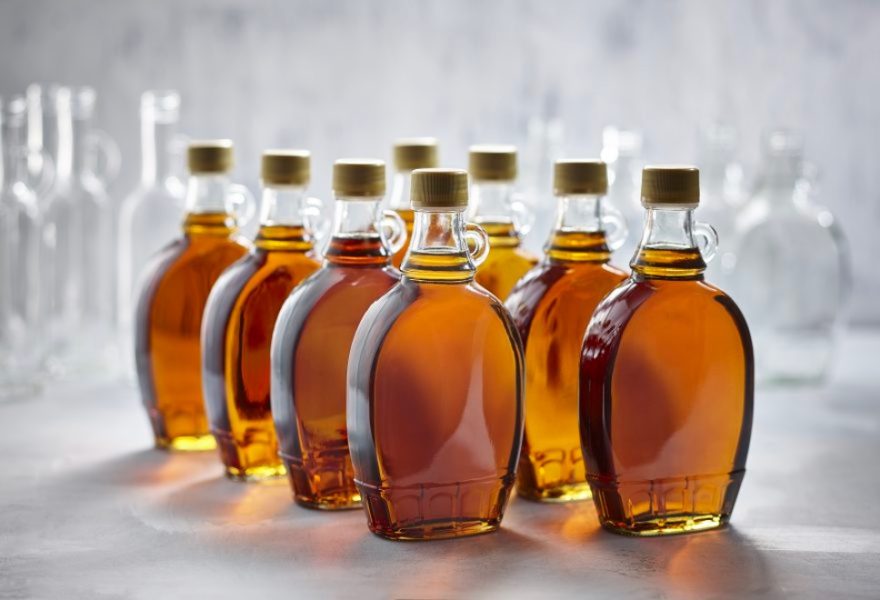Five Little-Known Facts About Maple Syrup

There are many things that we know and love about maple syrup – that it’s made in Canada, that it’s a natural ingredient, and that it tastes delicious, just to name a few!
But there is more to maple than meets the eye. Here at Maple from Canada, we know maple syrup inside and out, so we’d like to share a few little-known facts with you.
1. The story of maple started with a squirrel
Legend has it that many centuries ago, during a period of food scarcity, a Native American noticed a squirrel full of energy. He watched the animal drink “water” from a maple tree and realised it was the source of the squirrel’s vitality. From then on, maple water, or sap, started to be consumed as a fortifying drink.
Maple water was then re-discovered by Jacques Cartier. Intrigued by the strange-looking maple tree, he decided to cut it down and saw a large quantity of sweet maple water squirt from the wood.
Throughout the years, different processes have been developed to evaporate and boil the sap down to make the delicious, rich maple syrup we know and love today.
2. Maple syrup has nutritional value
Maple syrup is full of surprises – it’s a naturally nutritious product with no artificial colours, flavours or preservatives and is also rich in the mineral manganese, which helps to look after bones and connective tissue.
Additionally, it’s rich in riboflavin, which helps to reduce tiredness and fatigue. Lastly, it’s also a source of copper, which is important for looking after connective tissue, the nervous and immune systems.
As a result, many athletes, chefs, nutritionists and more count themselves as maple lovers. So go on, have another drizzle!
3. The colour and flavour of maple syrup changes throughout the seasons
At the start of the sugaring season, the syrup is generally clear with a light, sweet taste and it then becomes darker with a caramelised flavour as the season progresses throughout the spring. This then determines the classification of the maple syrup and there are four grades: golden, amber, dark and very dark.
Golden maple syrup is produced from the sap collected at the very beginning of the season and is light in colour. It has a sweet, delicate flavour, often with a hint of vanilla.
Amber maple syrup is harvested midway through the season and is still relatively light in colour. It has a pure, rich taste and is known for its smooth, more rounded flavour.
Dark maple syrup has a deeper and more intense colour and flavour and is harvested later in the season. It has its darker colour and more robust taste because the sugar content of the sap has fallen by this point in the season.
Very dark maple syrup is produced last in the season and is exceptionally robust, being the darkest in colour of all the grades. It has a rich, distinctive flavour that is more than that of dark maple and is best used for recipes that require a strong maple flavour.
4. There is science behind the amazing taste of maple
To make maple syrup, the sap of maple trees is heated, which triggers the all-important Maillard reaction. Observed by the French chemist Louis-Camille Maillard in 1912, this is the interaction between amino acids and sugar when food is subjected to high temperatures. It causes the browning and caramelisation of food when it’s cooked.
One theory is that the Maillard reaction creates the perception of umami – or deliciousness – in maple syrup, which would explain why it enhances the flavours of foods so well.
5. There are more than 150 species of maple tree in the world
We all know that maple syrup is made from the sap of maple trees, but did you know just how many species there are of this tree?
There is the Japanese maple, the Norway maple, the Paperbark maple and the Silver maple just to name a few. However, the Red maple and the Sugar maple are the only ones that give us the maple sap (or maple water) that’s indispensable to the production of maple syrup.
The frigid temperatures of the Québec winter are followed by the mild springtime conditions that cause the precious sap in these trees to flow, and to be gathered by the maple producers of Québec. So, maple syrup cannot be made in many places in the world!
If you know any fun, little-known facts about maple syrup, please share them with us on Facebook and Instagram.
A Source of Natural Energy
Maple syrup is a natural source of energy. Check out how maple can act as fuel before, during, and after exercise.
